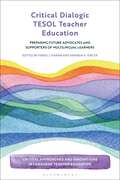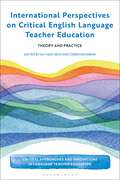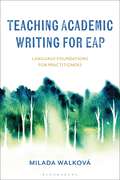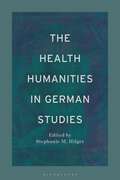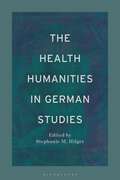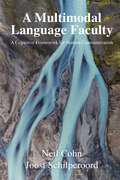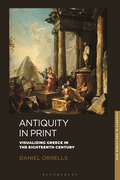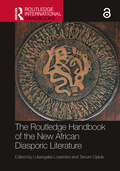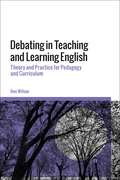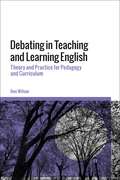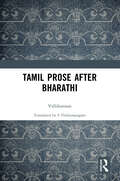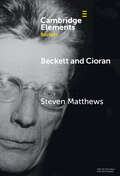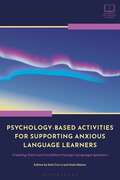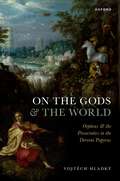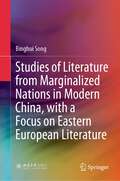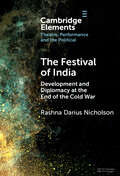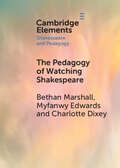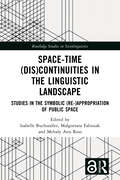- Table View
- List View
Critical Dialogic TESOL Teacher Education: Preparing Future Advocates and Supporters of Multilingual Learners (Critical Approaches and Innovations in Language Teacher Education)
by Fares J. Karam and Amanda K. KiblerThis edited volume showcases how teacher educators around the world engage with critical and dialogic approaches to prepare TESOL professionals. Language teachers are at the forefront of supporting the academic and social needs of increasingly ethnically and linguistically diverse student populations around the globe, and preparing critical and dialogic TESOL teachers with social justice orientations is essential to helping language learners fulfil their academic and linguistic potential. Although more experienced TESOL teachers may be able to agentively implement critical and dialogic approaches to instruction, we know little about what TESOL teacher educators do to help train and prepare language teachers who can do exactly that. In this volume, TESOL educators from various contexts share their experiences on how they engage with critical and dialogic approaches to reimagine TESOL teacher education. Chapter authors engage with different aspects of critical and dialogic approaches to present their visions for reimagining curricula, pedagogies, online spaces, and the roles of students, teachers, and teacher educators.
International Perspectives on Critical English Language Teacher Education: Theory and Practice (Critical Approaches and Innovations in Language Teacher Education)
This book showcases how teacher educators from diverse backgrounds, contexts, and realities approach English language teacher education with a critical stance. Organized into nine parts that explore different facets of English Language Teaching, each section opens with theoretical considerations chapters and features 24 practical application chapters.Written by renowned scholars including Graham Hall, Lili Cavalheiro, and Mario López Gopar, among others, the theoretical considerations chapters offer concise insights into current issues and controversies in the field, point out opportunities for criticality, and discuss implications for teacher education.Written by critically-oriented teacher educators/researchers from various parts of the world including Brazil, Germany, Morocco, Sweden, Turkey, and the USA, among others, the practical application chapters exhibit various ways to incorporate critical approaches in reshaping current teacher education practices (ranging from critical and queer pedagogy to translanguaging to multilingualism) along with a critical reflection of the potentials and the challenges involved in their application.
Teaching Academic Writing for EAP: Language Foundations for Practitioners
by Dr Milada WalkováThis book bridges the gap between theory and practice in the teaching of academic writing within English for Academic Purposes (EAP). Reviewing existing research on the language of academic writing and drawing respective pedagogical implications, the book focuses on the key issues of theoretical frameworks relevant to teaching academic writing, core written academic genres, the integration of language and content, textual organization and interaction, and formative feedback on writing. The author richly illustrates its key themes with authentic examples from student and expert writing, points out common myths and controversies in the teaching of academic writing, and identifies gaps in current research. To demonstrate how theoretical knowledge on academic writing can be applied in teaching practice, Milada Walková provides examples of suggested teaching activities for a variety of learner levels and contexts. The book serves as a comprehensive yet accessible resource for both novice and experienced EAP practitioners involved in the teaching and scholarship of academic writing.
Teaching Academic Writing for EAP: Language Foundations for Practitioners
by Dr Milada WalkováThis book bridges the gap between theory and practice in the teaching of academic writing within English for Academic Purposes (EAP). Reviewing existing research on the language of academic writing and drawing respective pedagogical implications, the book focuses on the key issues of theoretical frameworks relevant to teaching academic writing, core written academic genres, the integration of language and content, textual organization and interaction, and formative feedback on writing. The author richly illustrates its key themes with authentic examples from student and expert writing, points out common myths and controversies in the teaching of academic writing, and identifies gaps in current research. To demonstrate how theoretical knowledge on academic writing can be applied in teaching practice, Milada Walková provides examples of suggested teaching activities for a variety of learner levels and contexts. The book serves as a comprehensive yet accessible resource for both novice and experienced EAP practitioners involved in the teaching and scholarship of academic writing.
The Health Humanities in German Studies
by Stephanie M. HilgerThe first full-length study to bring together the fields of Health Humanities and German studies, this book features contributions from a range of key scholars and provides an overview of the latest work being done at the intersection of these two disciplines. In addition to surveying the current critical terrain in unparalleled depth, it also explores future directions that these fields may take. Organized around seven sections representing key areas of focus for both disciplines, this book provides important new insights into the intersections between Health Humanities, German Studies, and other fields of inquiry that have been gaining prominence over the past decade in academic and public discourse. In their contributions, the authors engage with disability studies, critical race studies, gender/embodiment studies, trauma studies, as well as animal/environmental studies.
The Health Humanities in German Studies
The first full-length study to bring together the fields of Health Humanities and German studies, this book features contributions from a range of key scholars and provides an overview of the latest work being done at the intersection of these two disciplines. In addition to surveying the current critical terrain in unparalleled depth, it also explores future directions that these fields may take. Organized around seven sections representing key areas of focus for both disciplines, this book provides important new insights into the intersections between Health Humanities, German Studies, and other fields of inquiry that have been gaining prominence over the past decade in academic and public discourse. In their contributions, the authors engage with disability studies, critical race studies, gender/embodiment studies, trauma studies, as well as animal/environmental studies.
A Multimodal Language Faculty: A Cognitive Framework for Human Communication
by Dr Neil Cohn Joost SchilperoordNatural human communication is multimodal. We pair speech with gestures, and combine writing with pictures from online messaging to comics to advertising. This richness of human communication remains unaddressed in linguistic and cognitive theories which maintain traditional amodal assumptions about language. What is needed is a new, multimodal paradigm. This book posits a bold reorganization of the structures of language, and heralds a reconsideration of its guiding assumptions. Human expressive behaviors like speaking, signing, and drawing may seem distinct, but they decompose into similar cognitive building blocks which coalesce in emergent states from a singular multimodal communicative architecture. This cognitive model accounts for unimodal and multimodal expression across all of our modalities, providing a “grand unified theory” that incorporates insights from formal linguistics, cognitive semantics, metaphor theory, Peircean semiotics, sign language, gesture, visual language, psycholinguistics, and cognitive neuroscience. Such a perspective reconfigures how we understand linguistic structure, diversity, universals, innateness, relativity, and evolution. A Multimodal Language Faculty directly confronts centuries-old notions of language and offers a compelling reimagination of what language is and how it works.
A Multimodal Language Faculty: A Cognitive Framework for Human Communication
by Dr Neil Cohn Joost SchilperoordNatural human communication is multimodal. We pair speech with gestures, and combine writing with pictures from online messaging to comics to advertising. This richness of human communication remains unaddressed in linguistic and cognitive theories which maintain traditional amodal assumptions about language. What is needed is a new, multimodal paradigm. This book posits a bold reorganization of the structures of language, and heralds a reconsideration of its guiding assumptions. Human expressive behaviors like speaking, signing, and drawing may seem distinct, but they decompose into similar cognitive building blocks which coalesce in emergent states from a singular multimodal communicative architecture. This cognitive model accounts for unimodal and multimodal expression across all of our modalities, providing a “grand unified theory” that incorporates insights from formal linguistics, cognitive semantics, metaphor theory, Peircean semiotics, sign language, gesture, visual language, psycholinguistics, and cognitive neuroscience. Such a perspective reconfigures how we understand linguistic structure, diversity, universals, innateness, relativity, and evolution. A Multimodal Language Faculty directly confronts centuries-old notions of language and offers a compelling reimagination of what language is and how it works.
Antiquity in Print: Visualizing Greece in the Eighteenth Century (New Directions in Classics)
by Daniel OrrellsDaniel Orrells examines the ways in which the ancient world was visualized for Enlightenment readers, and reveals how antiquarian scholarship emerged as the principal technology for envisioning ancient Greek culture, at a time when very few people could travel to Greece which was still part of the Ottoman Empire. Offering a fresh account of the rise of antiquarianism in the 18th century, Orrells shows how this period of cultural progression was important for the invention of classical studies. In particular, the main focus of this book is on the visionary experimentalism of antiquarian book production, especially in relation to the contentious nature of ancient texts. With the explosion of the Quarrel between the Ancients and the Moderns, eighteenth-century intellectuals, antiquarians and artists such as Giambattista Vico, Johann Joachim Winckelmann, the Comte de Caylus, James Stuart, Julien-David Leroy, Giovanni Battista Piranesi and Pierre-François Hugues d'Hancarville all became interested in how printed engravings of ancient art and archaeology could visualize a historical narrative. These figures theorized the relationship between ancient text and ancient material and visual culture - theorizations which would pave the way to foundational questions at the heart of the discipline of classical studies and neoclassical aesthetics.
Antiquity in Print: Visualizing Greece in the Eighteenth Century (New Directions in Classics)
by Daniel OrrellsDaniel Orrells examines the ways in which the ancient world was visualized for Enlightenment readers, and reveals how antiquarian scholarship emerged as the principal technology for envisioning ancient Greek culture, at a time when very few people could travel to Greece which was still part of the Ottoman Empire. Offering a fresh account of the rise of antiquarianism in the 18th century, Orrells shows how this period of cultural progression was important for the invention of classical studies. In particular, the main focus of this book is on the visionary experimentalism of antiquarian book production, especially in relation to the contentious nature of ancient texts. With the explosion of the Quarrel between the Ancients and the Moderns, eighteenth-century intellectuals, antiquarians and artists such as Giambattista Vico, Johann Joachim Winckelmann, the Comte de Caylus, James Stuart, Julien-David Leroy, Giovanni Battista Piranesi and Pierre-François Hugues d'Hancarville all became interested in how printed engravings of ancient art and archaeology could visualize a historical narrative. These figures theorized the relationship between ancient text and ancient material and visual culture - theorizations which would pave the way to foundational questions at the heart of the discipline of classical studies and neoclassical aesthetics.
The Routledge Handbook of the New African Diasporic Literature (Routledge International Handbooks)
by Lokangaka Losambe Tanure OjaideThe Routledge Handbook of the New African Diasporic Literature introduces world literature readers to the transnational, multivocal writings of immigrant African authors. Covering works produced in Europe, North America, and elsewhere in the world, this book investigates three major aesthetic paradigms in African diasporic literature: the Sankofan wave (late 1960s–early 1990s); the Janusian wave (1990s–2020s); and the Offshoots of the New Arrivants (those born and growing up outside Africa).Written by well-established and emerging scholars of African and diasporic literatures from across the world, the chapters in the book cover the works of well-known and not-so-well-known Anglophone, Francophone, and Lusophone writers from different theoretical positionalities and critical approaches, pointing out the unique innovative artistic qualities of this major subgenre of African literature. The focus on the “diasporic consciousness” of the writers and their works sets this handbook apart from others that solely emphasize migration, which is more of a process than the community of settled African people involved in the dynamic acts of living reflected in diasporic writings.This book will appeal to researchers and students from across the fields of Literature, Diaspora Studies, African Studies, Migration Studies, and Postcolonial Studies.
The Routledge Handbook of the New African Diasporic Literature (Routledge International Handbooks)
by Lokangaka Losambe Tanure OjaideThe Routledge Handbook of the New African Diasporic Literature introduces world literature readers to the transnational, multivocal writings of immigrant African authors. Covering works produced in Europe, North America, and elsewhere in the world, this book investigates three major aesthetic paradigms in African diasporic literature: the Sankofan wave (late 1960s–early 1990s); the Janusian wave (1990s–2020s); and the Offshoots of the New Arrivants (those born and growing up outside Africa).Written by well-established and emerging scholars of African and diasporic literatures from across the world, the chapters in the book cover the works of well-known and not-so-well-known Anglophone, Francophone, and Lusophone writers from different theoretical positionalities and critical approaches, pointing out the unique innovative artistic qualities of this major subgenre of African literature. The focus on the “diasporic consciousness” of the writers and their works sets this handbook apart from others that solely emphasize migration, which is more of a process than the community of settled African people involved in the dynamic acts of living reflected in diasporic writings.This book will appeal to researchers and students from across the fields of Literature, Diaspora Studies, African Studies, Migration Studies, and Postcolonial Studies.
Debating in Teaching and Learning English: Theory and Practice for Pedagogy and Curriculum
by Ben WIlsonThis book offers the first full-length treatment of the topic of debating as a method of developing English Foreign Language (EFL) speaking, inviting scholars and practitioners to reflect on the demands of the current age for moving forward educational practice. While debating is a well-known method of dialogic speaking and is widely practiced, the extent to which it is integrated in adult TEFL has not been established, and an understanding of its affordances for developing foreign language speaking is also limited.This book fills the gap in the field of TESOL and applied linguistics on the affordances of debating as a form of dialogic speaking that can promote a holistic understanding and improvement of experience of education, and indeed academic outcomes. The two main themes that situate the work are those of dialogic speaking and affect (at times referred to as 'humanistic', 'positive psychology' and 'social and emotional learning'). The book details the experiences of an adult EFL debate group in a private language school in the North of Italy. It reports how the participants experience the pedagogy so as to offer insights into it as a form of teaching speaking in adult EFL, as well as providing a practical framework with lesson plans and curriculum. The affordances of debating emerge as being social, cognitive, educational and communicative, and are discussed alongside the work of language teaching scholars Curran and Freire, and more broadly within a Social Constructivist approach to education. As such, debating is discussed as being a holistic and dialogic form of pedagogy. Particular attention to experience - often affective - is also found to be fundamental in planning and assessing educational outcomes for both teachers and learners.
Debating in Teaching and Learning English: Theory and Practice for Pedagogy and Curriculum
by Ben WIlsonThis book offers the first full-length treatment of the topic of debating as a method of developing English Foreign Language (EFL) speaking, inviting scholars and practitioners to reflect on the demands of the current age for moving forward educational practice. While debating is a well-known method of dialogic speaking and is widely practiced, the extent to which it is integrated in adult TEFL has not been established, and an understanding of its affordances for developing foreign language speaking is also limited.This book fills the gap in the field of TESOL and applied linguistics on the affordances of debating as a form of dialogic speaking that can promote a holistic understanding and improvement of experience of education, and indeed academic outcomes. The two main themes that situate the work are those of dialogic speaking and affect (at times referred to as 'humanistic', 'positive psychology' and 'social and emotional learning'). The book details the experiences of an adult EFL debate group in a private language school in the North of Italy. It reports how the participants experience the pedagogy so as to offer insights into it as a form of teaching speaking in adult EFL, as well as providing a practical framework with lesson plans and curriculum. The affordances of debating emerge as being social, cognitive, educational and communicative, and are discussed alongside the work of language teaching scholars Curran and Freire, and more broadly within a Social Constructivist approach to education. As such, debating is discussed as being a holistic and dialogic form of pedagogy. Particular attention to experience - often affective - is also found to be fundamental in planning and assessing educational outcomes for both teachers and learners.
Tamil Prose after Bharathi
by VallikannanBefore Bharathi, Tamil writers considered writing in a way readers cannot understand as a mark of punditry. It was almost a tradition to employ a difficult style to explain even a simple matter. After showing the readers how involuted and difficult the styles of writers before Bharathi were, Vallikannan discusses the innovative features of Bharathi and the impact they made on his successors. He discusses the individualistic features of several great writers of Tamil fiction and their contribution to the development of Tamil as a language reflecting modernity and capable of coping with the knowledge explosion witnessed up to the present day.The book discusses the works of the stalwarts of Tamil fiction: Kalki, Puthumaipithan, Ku. Pa. Rajagopalan, La. Sa. Ra., Mouni, Jayakanthan, Sujatha and many more including a few Sri Lankan Tamil writers. Apart from these, Vallikannan has made an incisive study of the oratorical style of C. N. Annadurai, one of the most accomplished statesmen of Tamil Nadu.This book will help students, researchers, academics and Tamil literature enthusiasts get a good understanding of the Tamil writers discussed and the development of Tamil prose through the major part of the twentieth century.
Beckett and Cioran (Elements in Beckett Studies)
by null Steven MatthewsThis Element discusses the association between Samuel Beckett, and the Romanian-born philosopher, E. M. Cioran. It draws upon the known biographical detail, but, more substantially, upon the terms of Beckett's engagement with Cioran's writings, from the 1950s to the 1970s. Certain of Cioran's key conceptualisations, such as that of the 'meteque', and his version of philosophical scepticism, resonate with aspects of Beckett's writing as it evolved beyond the 'siege in the room'. More particularly, aspects of Cioran's conclusion about the formal nature that philosophy must assume chime with some of the formal decisions taken by Beckett in the mid-late prose. Through close reading of some of Beckett's key works such as Texts for Nothing and How It Is, and through consideration of Beckett's choices when translating between English and French, the issues of identity and understanding shared by these two settlers in Paris are mutually illuminated.
Psychology-Based Activities for Supporting Anxious Language Learners: Creating Calm and Confident Foreign Language Speakers (Bloomsbury Guidebooks for Language Teachers)
A quiet, anxious class can be an uncomfortable learning experience for all concerned, yet it can be a situation language educators regularly face. This volume offers a range of activities which teachers can use with both classes and individual students to reduce their anxiety and increase their confidence for speaking. Drawn from a variety of theoretical backgrounds and educational contexts, the activities are presented in a clear and easy-to-follow format, allowing educators to choose according to the needs of their students and style of instruction. By describing the theories, reasons and events which gave rise to the development of the activities, readers will be able to recognise their own experiences and easily realise how they might put the activities into practice in their own situations. Theories and practices explored include: mindfulness, flow practices, self-esteem theory, Stoic philosophy, attribution retraining, Cognitive Behaviour Therapy (CBT) and positive evaluation.
Psychology-Based Activities for Supporting Anxious Language Learners: Creating Calm and Confident Foreign Language Speakers (Bloomsbury Guidebooks for Language Teachers)
by Neil Curry and Kate MaherA quiet, anxious class can be an uncomfortable learning experience for all concerned, yet it can be a situation language educators regularly face. This volume offers a range of activities which teachers can use with both classes and individual students to reduce their anxiety and increase their confidence for speaking. Drawn from a variety of theoretical backgrounds and educational contexts, the activities are presented in a clear and easy-to-follow format, allowing educators to choose according to the needs of their students and style of instruction. By describing the theories, reasons and events which gave rise to the development of the activities, readers will be able to recognise their own experiences and easily realise how they might put the activities into practice in their own situations. Theories and practices explored include: mindfulness, flow practices, self-esteem theory, Stoic philosophy, attribution retraining, Cognitive Behaviour Therapy (CBT) and positive evaluation.
On the Gods and the World: Orpheus and the Presocratics in the Derveni Papyrus
by Vojt?ch Hladk?The Derveni papyrus is a multi-layered and intricate philosophical and religious treatise written in Greek, probably just before 400 BCE. Since its discovery in 1962, the papyrus has attracted the attention of scholars in several areas of Classical studies, mostly ancient philosophy and religion, but also literary studies. The anonymous author of the text quotes a previously unknown Orphic poem and comments on it using philosophical motifs and concepts borrowed from various Presocratic thinkers but especially Heraclitus and the Anaxagoreans. The book presents a new interpretation of various aspects of this complex text: situating the treatise within the tradition of allegorical interpretation; providing an interpretation of the opening columns, which describe a peculiar ritual and contain some Heraclitean material, including, as the study argues, some previously unknown fragments; reconstructing the contents of the Orphic poem upon which the Derveni author comments; examining various allegorical devices employed by the Derveni author in his explanation of the Orphic poem, following his commentary in detail; and finally, discussing the likely intellectual background in which the Derveni treatise originated. In general, the study argues that rather than being the work of a philosophising Orphic initiate, the Derveni treatise is a philosophical text whose aim was to explain a nonstandard religious poem. The commentary explains the Orphic poem from a perspective influenced by discussions among the followers of philosophy of Anaxagoras and Heraclitus, and employs reflections on the use and function of language found in the writings of some contemporary thinkers. Based on an analysis of sources upon which the Derveni papyrus is based, it is concluded that its author was probably active in Athens in late fifth century BCE and may have been a person close to Socrates' teacher Archelaus.
On the Gods and the World: Orpheus and the Presocratics in the Derveni Papyrus
by Vojt?ch Hladk?The Derveni papyrus is a multi-layered and intricate philosophical and religious treatise written in Greek, probably just before 400 BCE. Since its discovery in 1962, the papyrus has attracted the attention of scholars in several areas of Classical studies, mostly ancient philosophy and religion, but also literary studies. The anonymous author of the text quotes a previously unknown Orphic poem and comments on it using philosophical motifs and concepts borrowed from various Presocratic thinkers but especially Heraclitus and the Anaxagoreans. The book presents a new interpretation of various aspects of this complex text: situating the treatise within the tradition of allegorical interpretation; providing an interpretation of the opening columns, which describe a peculiar ritual and contain some Heraclitean material, including, as the study argues, some previously unknown fragments; reconstructing the contents of the Orphic poem upon which the Derveni author comments; examining various allegorical devices employed by the Derveni author in his explanation of the Orphic poem, following his commentary in detail; and finally, discussing the likely intellectual background in which the Derveni treatise originated. In general, the study argues that rather than being the work of a philosophising Orphic initiate, the Derveni treatise is a philosophical text whose aim was to explain a nonstandard religious poem. The commentary explains the Orphic poem from a perspective influenced by discussions among the followers of philosophy of Anaxagoras and Heraclitus, and employs reflections on the use and function of language found in the writings of some contemporary thinkers. Based on an analysis of sources upon which the Derveni papyrus is based, it is concluded that its author was probably active in Athens in late fifth century BCE and may have been a person close to Socrates' teacher Archelaus.
Tamil Prose after Bharathi
by VallikannanBefore Bharathi, Tamil writers considered writing in a way readers cannot understand as a mark of punditry. It was almost a tradition to employ a difficult style to explain even a simple matter. After showing the readers how involuted and difficult the styles of writers before Bharathi were, Vallikannan discusses the innovative features of Bharathi and the impact they made on his successors. He discusses the individualistic features of several great writers of Tamil fiction and their contribution to the development of Tamil as a language reflecting modernity and capable of coping with the knowledge explosion witnessed up to the present day.The book discusses the works of the stalwarts of Tamil fiction: Kalki, Puthumaipithan, Ku. Pa. Rajagopalan, La. Sa. Ra., Mouni, Jayakanthan, Sujatha and many more including a few Sri Lankan Tamil writers. Apart from these, Vallikannan has made an incisive study of the oratorical style of C. N. Annadurai, one of the most accomplished statesmen of Tamil Nadu.This book will help students, researchers, academics and Tamil literature enthusiasts get a good understanding of the Tamil writers discussed and the development of Tamil prose through the major part of the twentieth century.
Studies of Literature from Marginalized Nations in Modern China, with a Focus on Eastern European Literature
by Binghui SongThis book presents the first systematic study of the 100-year history of translation, research, reception, and influence of Central and Eastern European literature in China from the late Qing Dynasty to the end of the twentieth century. This study of Eastern European literature from the perspective of Sino-foreign literary relations is based on extensive research into the translation and reception of Central and Eastern European writers such as Milan Kundera, Sándor Petőfi, Henryk Sienkiewicz, Julius Fucik, and Bertolt Brecht. Since the late nineteenth century, the major Chinese writers have paid special attention to the literature of the marginalized Eastern European nations when they have to translate from translations since few of them understand Eastern European languages. The book seeks to identify what attracted the founders of new Chinese literature to Eastern European literature and to define its unique significance for the construction of modern Chinese literature.
The Festival of India: Development and Diplomacy at the End of the Cold War (Elements in Theatre, Performance and the Political)
by null Rashna Darius NicholsonAn in-depth study of the Festival of India (1985–1986) in the United States, one of the biggest events ever mounted to promote goodwill between two countries. Comprising more than seven hundred programs of music, dance, drama, film shows, art exhibitions, and workshops sponsored by over two hundred cultural institutions across over a hundred cities, the festival constituted a prismatic event that refracted the complex forces at play on the global stage during the 1980s. The Element delineates how this multi-sited spectacle of unprecedented size and near unfathomable political, economic, and cultural influence impacted theatre and performance studies. Simultaneously, it traces how two complex historical shifts were communicated to the global public at the end of the Cold War: India's desire to transition from planned Nehruvian socialism to laissez faire capitalism and the efflorescence of the model of 'cultural development' that centred the arts in development.
The Pedagogy of Watching Shakespeare (Elements in Shakespeare and Pedagogy)
by null Bethan Marshall null Myfanwy Edwards null Charlotte DixieThe pedagogy of acting out Shakespeare has been extensive. Less work has been done on how students learn through spectatorship. This element will consider all within the current context of Shakespeare teaching in schools. Using grounded research, it will include work undertaken on a schools National Theatre production of Macbeth, as well as classroom-based, action research, using a variety of digital performances of Shakespeare plays. Both find means of extending student knowledge in unexpected ways through encountering interpretations of Shakespeare that the students had not considered. In reflecting on the practice of watching Shakespeare in an educational context- both at the theatre and in the classroom- this Element hopes to offer suggestions for how teachers might re-think the ways in which they present Shakespeare performed to their students particularly as a powerful way of building personal and critical responses to the plays.
Space-Time: Studies in the Symbolic (Re-)appropriation of Public Space (Routledge Studies in Sociolinguistics)
by Isabelle Buchstaller, Małgorzata Fabiszak, and Melody Ann RossThis collection spotlights the diachronic dimensions of the linguistic landscape, the importance of exploring temporal dissonances in historical events in order to better understand semiotic, political, and social transformations across different communities over the last century.The volume seeks to expand the current borders of linguistic landscape (LL) research by situating the analysis of signs in the LL within their time–space organization, which has been understudied in existing scholarship. The book, featuring chapters from established and emerging scholars, argues that a focus on the historicity of the city text can reveal unique insights into the role of semiotic processes as precursors and support mechanisms for political and social changes. The collection is structured around different temporal clusters and geographic contexts across the globe where shorter and longer waves of politically driven resemioticization can be most sharply observed – post-colonial communities; post-communist societies; and recent and current sociopolitical upheavals. Taken together, the volume proposes a kaleidoscope view of the complex temporalities that underpin multimodal discourses in contested public spaces, offering new directions for LL research.This book will be of interest to students and scholars in sociolinguistics, discourse analysis, semiotics, visual anthropology, and political science.The Introduction and Chapter 8 of this book is freely available as a downloadable Open Access PDF at http://www.taylorfrancis.com under a Creative Commons Attribution-Non Commercial-No Derivatives (CC-BYNC-ND) 4.0 license.
